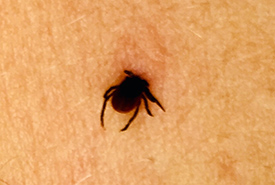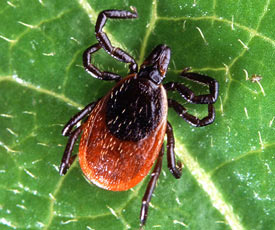Don’t let the ticks bite!

Backpack Essentials (Image by NCC)
This blog post is part of the Backpack Essentials series, a series that explores the items that Nature Conservancy of Canada (NCC) staff carry with them when heading outside. It is inspired by the quarterly Nature Conservancy of Canada Magazine and our Nature Destinations program. To learn more about NCC’s properties across Canada that you can visit, check out naturedestinations.ca.
It’s finally summer. The sun is shining and nature is calling for you. With COVID-19 restrictions slowly lifting and hiking trails re-opening to public across the country, you may be thinking about spending more time in nature.
Disclaimer: Please check your local municipal websites for the latest information on trail access. See the latest updates on access to NCC lands here.
What you may not know is that there may be small but dangerous creatures lurking in the leaves. Called ticks, these arachnids are considered a nuisance to every nature lover due to the possibility of being bitten and contracting infections, including the infection that causes Lyme disease.
But don’t let your fear of ticks stop you from enjoying your time outdoors. Mhairi McFarlane, director of science and stewardship at the Nature Conservancy of Canada’s (NCC’s) Ontario Region, has shared some advice on how to protect yourself against these tiny, spider-like, egg-shaped creatures.
Related content
Protect yourself

Tips for tick safety (Graphic by NCC)
Tick populations begin to grow, generally, from early spring to summer. To reproduce and nurture their eggs, females of all tick species need to consume blood from a bird or mammal, including humans. Although ticks can’t jump or fly, they can attach themselves to their desired host by waiting on a leaf and climbing onto an individual passing by.
“This is why you should always wear long pants and tuck them into your socks,” suggests Mhairi. “Shirts should also be tucked in. Make sure every opening is covered.”
Whenever you are going outdoors, you should always apply a good-quality bug spray that contains DEET. However, to specifically prevent ticks, Mhairi recommends wearing clothing that has been pre-treated with a bug-repellent called permethrin.
Another easy way to reduce your risk of picking up an unwelcome hitchhiker is to stay on designated trails in natural areas. If you’re hiking with family, friends or your dog, make sure that they too are staying on designated trails. If Fido gallops through the off-trail vegetation, he could pick up ticks that may then crawl onto you later.
“Our field staff do their best to keep trails clean and accessible, thereby reducing contact between you and any vegetation that may be carrying ticks,” said Mhairi.
Once bitten…

A tick with its head buried in someone’s skin (Photo by falconpoule CC BY-NC)
If you do notice a tick on you, with its head buried in your skin, you should pull out its entire body using either tweezers or a tick key. When pulling on the tick, aim for its mouthpart and never its abdomen, as that can push the mouthpart further into your skin. But don’t destroy the critter! Keep it in a jar or container for your doctor.
After removing the tick and putting it in a container, the bite site should be rinsed with water and disinfected immediately with an antiseptic. Within three days of being bitten, bring the tick with you to a medical doctor’s office and have it tested for Lyme disease.
Not every tick bite results in Lyme disease, so there is no need to panic. There are many tick species in the wild, and only a few carry the bacteria that leads to infections like Lyme disease. The notorious deer tick and lone star tick are the only species that transmit infectious bacteria to humans. Deer ticks, a carrier of the Lyme disease-causing bacteria, usually feed on deer but sometimes feed on mice, too. When taking the blood of infected white-footed mice and deer mice, these ticks also ingest bacteria at the same time. If they then bite a human afterward, they may transfer the bacteria into the human’s bloodstream, which can cause Lyme disease.

Adult deer tick (Photo by Scott Bauer/Wikimedia Commons)
The reasons for the increasing number of ticks at our favourite outdoor spots are “complex and interlinked and likely include climate change, changes in mammal populations, and even changes in vegetation structure and composition,” added Mhairi. With changing ecological relationships and more invasive plants affecting our local ecosystems, tick populations have found it easier to reproduce and survive.
“A landscape dominated by native plants, which support mammal predators as well as their prey, may have a more ‘balanced’ relationship between deer and mice and their respective predators, reducing the chances of ticks having a blood meal and laying eggs,” said Mhairi. This makes ecosystem restoration and the fight against invasive species all the more important.
The next time you enjoy a walk or hike outdoors in the height of summer, keep these tips in mind. Have fun in nature, but don’t let the ticks bite!
The Conservation Internship Program is funded in part by the Government of Canada’s Summer Work Experience program.




